Beijing cuisine
| Beijing cuisine | |||||||
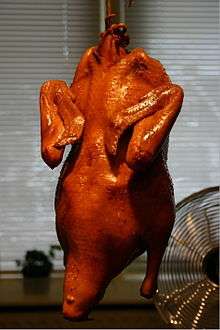 | |||||||
| Chinese | 北京菜 | ||||||
|---|---|---|---|---|---|---|---|
| |||||||
| Jing cuisine | |||||||
| Chinese | 京菜 | ||||||
| Literal meaning | cuisine of the capital | ||||||
| |||||||
| Beiping cuisine | |||||||
| Chinese | 北平菜 | ||||||
| |||||||
 |
| This article is part of the series |
| Chinese cuisine |
|---|
|
|
Ingredients and types of food |
|
Beijing cuisine, also known as Jing cuisine and Mandarin cuisine, and as Beiping cuisine in Taiwan, is the local cuisine of Beijing, the national capital of China.
Background
As Beijing has been the capital of China for centuries, its cuisine is influenced by culinary traditions from all over China, but the style that has the greatest influence on Beijing cuisine is that of the eastern coastal province of Shandong.[1][2][3][4] Beijing cuisine has itself, in turn, also greatly influenced other Chinese cuisines, particularly the cuisine of Liaoning, the Chinese imperial cuisine, and the Chinese aristocrat cuisine.[1][2][3][4]
Another tradition that influenced Beijing cuisine (as well as influenced by the latter itself) is the Chinese imperial cuisine that originated from the "Emperor's Kitchen" (御膳房; yùshànfáng), which referred to the cooking facilities inside the Forbidden City, where thousands of cooks from different parts of China showed their best culinary skills to please the imperial family and officials. Therefore, it is sometimes difficult to determine the actual origin of a dish as the term "Mandarin" is generalised and refers not only to Beijing, but other provinces as well. However, some generalisation of Beijing cuisine can be characterised as follows: Foods that originated in Beijing are often snacks rather than main courses, and they are typically sold by small shops or street vendors. There is emphasis on dark soy paste, sesame paste, sesame oil and scallions, and fermented tofu is often served as a condiment. In terms of cooking techniques, methods relating to different ways of frying are often used.[1][4] There is less emphasis on rice as an accompaniment as compared to many other regions in China, as local rice production in Beijing is limited by the relatively dry climate.
Many dishes in Beijing cuisine that are served as main courses are derived from a variety of Chinese Halal foods, particularly lamb and beef dishes,[5] as well as from Huaiyang cuisine.
Huaiyang cuisine has been praised since ancient times in China, and it was a general practice for an official travelling to Beijing to take up a new post to bring along with him a chef specialising in Huaiyang cuisine. When these officials had completed their terms in the capital and returned to their native provinces, most of the chefs they brought along often remained in Beijing. They opened their own restaurants or were hired by wealthy locals.[1][4] The imperial clan of the Ming dynasty, the House of Zhu, who had ancestry from Jiangsu Province, also contributed greatly in introducing Huaiyang cuisine to Beijing when the capital was moved from Nanjing to Beijing in the 15th century, because the imperial kitchen was mainly Huaiyang style. The element of traditional Beijing culinary and gastronomical cultures of enjoying artistic performances such as Beijing opera while dining directly developed from the similar practice in the culture of Jiangsu and Huaiyang cuisines.[1][2][3][4][6]
Chinese Islamic cuisine is another important component of Beijing cuisine, and was first prominently introduced when Beijing became the capital of the Yuan dynasty. However, the most significant contribution to the formation of Beijing cuisine came from Shandong cuisine, as most chefs from Shandong Province came to Beijing en masse during the Qing dynasty. Unlike the earlier two cuisines, which were brought by the ruling class such as nobles, aristocrats and bureaucrats, and then spread to the general populace, the introduction of Shandong cuisine begun with serving the general populace, with much wider market segment, from wealthy merchants to the working class.
History
The Qing dynasty was a major period in the formation of Beijing cuisine. Before the Boxer Rebellion, the foodservice establishments in Beijing were strictly stratified by the foodservice guild. Each category of the establishment was specifically based on its ability to provide for a particular segment of the market. The top ranking foodservice establishments served nobles, aristocrats, and wealthy merchants and landlords, while lower ranking foodservice establishments served the populace of lower financial and social status. It was during this period when Beijing cuisine gained fame and became recognised by the Chinese culinary society, and the stratification of the foodservice was one of its most obvious characteristics as part of its culinary and gastronomic cultures during this first peak of its formation.[1][2][3][4]
The official stratification was an integral part of the local culture of Beijing and it was not finally abolished officially after the end of the Qing dynasty, which resulted in the second peak in the formation of Beijing cuisine. Meals previously offered to nobles and aristocrats were made available to anyone who could afford them instead of being restricted only to the upper class. As chefs freely switched between jobs offered by different foodservice establishments, they brought their skills that further enriched and developed Beijing cuisine. Though the stratification of food services in Beijing was no longer effected by imperial laws, the structure more or less remained despite continuous weakening due to the financial background of the local clientele. The different classes are listed in the following subsections.[1][2][3][4][6]
Zhuang
Foodservice establishments with names ending with the Chinese character zhuang (庄; 莊; zhuāng; "village"), or zhuang zihao (庄字号; 莊字號; zhuāng zìhào; "village brand"), were the top-ranking foodservice establishments, not only in providing foods, but entertainment as well. The form of entertainment provided was usually Beijing opera, and foodservice establishments of this class always had long-term contracts with a Beijing opera troupe to perform onsite. Moreover, foodservice establishments of this class would always have long-term contracts with famous performers, such as national-treasure-class performers, to perform onsite, though not on a daily basis. Foodservice establishments of this category did not accept any different customers on a walk-in basis, but instead, only accepted customers who came as a group and ordered banquets by appointment, and the banquets provided by foodservice establishments of this category often included most, if not all tables, at the site. The bulk of the business of foodservice of this category, however, was catering at customers' homes or other locations, and such catering was often for birthdays, marriages, funerals, promotions and other important celebrations and festivals. When catering, these foodservice establishments not only provided what was on the menu, but fulfilled customers' requests.
Foodservice establishments categorised as leng zhuangzi (冷庄子; 冷莊子; lěng zhuāngzǐ; "cold village") lacked any rooms to host banquets, and thus their business was purely catering.
Tang
Foodservice establishments with names ending with the Chinese character tang (堂; táng; "auditorium"), or tang zihao (堂字号; 堂字號; táng zìhào; "auditorium brand"), are similar to foodservice establishments with names ending with the Chinese character zhuang, but the business of these second-class foodservice establishments were generally evenly divided among onsite banquet hosting and catering (at customers' homes). Foodservice establishments of this class would also have long-term contracts with Beijing opera troupes to perform onsite, but they did not have long-term contracts with famous performers, such as national-treasure-class performers, to perform onsite on regular basis; however these top performers would still perform at foodservice establishments of this category occasionally. In terms of catering at the customers' sites, foodservice establishments of this category often only provided dishes strictly according to their menu, and would not provide any dishes that were not on the menu.
Ting
Foodservice establishments with names ending with the Chinese character ting (厅; 廳; tīng; "foyer"), or ting zihao (厅字号; 廳字號; tīng zìhào; "foyer brand") are foodservice establishments which had more business in onsite banquet hosting than catering at customers' homes. For onsite banquet hosting, entertainment was still provided, but foodservice establishments of this category did not have long-term contracts with Beijing opera troupes, so that performers varied from time to time, and top performers usually did not perform here or at any lower-ranking foodservice establishments. For catering, different foodservice establishments of this category were incapable of handling significant catering on their own, but generally had to combine resources with other foodservice establishments of the same ranking (or lower) to do the job.
Yuan
Foodservice establishments with names ending with the Chinese character yuan (园; 園; yuán; "garden"), or yuan zihao (园字号; 園字號; yuán zìhào; "garden brand") did nearly all their business in hosting banquets onsite. Entertainment was not provided on a regular basis, but there were stages built onsite for Beijing opera performers. Instead of being hired by the foodservice establishments like in the previous three categories, performers at foodservice establishments of this category were usually contractors who paid the foodservice establishment to perform and split the earnings according to a certain percentage. Occasionally, foodservice establishments of this category would be called upon to help cater at customers' homes, and like foodservice establishments with names ending with the Chinese character ting, they could not do the job on their own but had to work with others, never taking the lead as foodservice establishments with names ending with the Chinese character ting could.
Lou
Foodservice establishments with names ending with the Chinese character lou (楼; 樓; lóu; "storey"), or lou zihao (楼字号; 樓字號; lóu zìhào; "storey brand") did the bulk of their business hosting banquets onsite by appointment. In addition, a smaller portion of the business was in serving different customers onsite on a walk-in basis. Occasionally, when catering at customers' homes, foodservice establishments of this category would only provide the few specialty dishes they were famous for.
Ju
Foodservice establishments with names ending with the Chinese character ju (居; jū; "residence"), or ju zihao (居字号; 居字號; jū zìhào; "residence brand") generally divided their business evenly into two areas: serving different customers onsite on a walk-in basis, and hosting banquets by appointment for customers who came as one group. Occasionally, when catering at the customers' homes, foodservice establishments of this category would only provide the few specialty dishes they were famous for, just like foodservice establishments with names ending with the Chinese character lou. However, unlike those establishments, which always cooked their specialty dishes on location, foodservice establishment of this category would either cook on location or simply bring the already-cooked food to the location.
Zhai
Foodservice establishments with names ending with the Chinese character zhai (斋; 齋; zhāi; "study"), or zhai zihao (斋字号; 齋字號; zhāi zìhào; "study brand") were mainly in the business of serving different customers onsite on a walk-in basis, but a small portion of their income did come from hosting banquets by appointment for customers who came as one group. Just like foodservice establishments with names ending with the Chinese character ju, when catering at customers’ homes, foodservice establishments of this category would also only provide the few specialty dishes they are famous for, but they would mostly bring the already-cooked dishes to the location, and would only cook on location occasionally.
Fang
Foodservice establishments with names ending with the Chinese character fang (坊; fǎng; "workshop"), or fang zihao (坊字号; 坊字號; fǎng zìhào; "workshop brand"). Foodservice establishments of this category generally did not offer the service of hosting banquets made by appointment for customers who came as one group, but instead, often only offered to serve different customers onsite on a walk-in basis. Foodservice establishments of this category or lower would not be called upon to perform catering at the customers' homes for special events.
Guan
Foodservice establishments with names ending with the Chinese character guan (馆; 館; guǎn; "restaurant"), or guan zihao (馆字号; 館字號; guǎn zìhào; "restaurant brand"). Foodservice establishments of this category mainly served different customers onsite on a walk-in basis, and in addition, a portion of the income would be earned from selling to-goes.
Dian
Foodservice establishments with names ending with the Chinese character dian (店; diàn; "shop"), or dian zihao (店字号; 店字號; diàn zìhào; "shop brand"). Foodservice establishments of this category had their own place, like all previous categories, but serving different customers to dine onsite on a walk-in basis only provided half of the overall income, while the other half came from selling to-goes.
Pu
Foodservice establishments with name ending with the Chinese character pu (铺; 鋪; pù; "store"), or pu zihao (铺字号; 鋪字號; pù zìhào; "store brand"). Foodservice establishments of this category ranked next to the last, and they were often named after the owners' last names. Foodservice establishments of this category had fixed spots of business for having their own places, but not as large as those belonging to the category of dian, and thus did not have tables, but only seats for customers. As a result, the bulk of the income of foodservice establishments of this category was from selling to-goes, while income earned from customers dining onsite only provided a small portion of the overall income.
Tan
Foodservice establishments with names ending with the Chinese character tan (摊; 攤; tān; "stand"), or tan zihao (摊字号; 攤字號; tān zìhào; "stand brand"). The lowest ranking foodservice establishments without any tables, and selling to-goes was the only form of business. In addition to name the food stand after the owners' last name or the food sold, these food stands were also often named after the owners' nicknames.
Notable dishes and street foods
Meat and poultry dishes
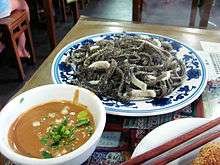
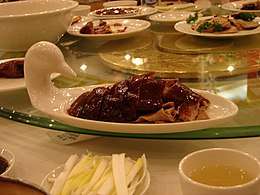
| English | Traditional Chinese | Simplified Chinese | Pinyin | Notes |
|---|---|---|---|---|
| Beef wrapped in pancake | 門釘肉餅 | 门钉肉饼 | méndīng ròubǐng | |
| Beggar's Chicken | 富貴雞 | 富贵鸡 | fùguì jī | The dish's name literally means "rich chicken" or "wealthy chicken". It is also known as jiaohua ji (叫化鸡; 叫化雞; jiàohuā jī).[7] |
| Cold pig's ears in sauce | 拌雙脆 | 拌双脆 | bàn shuāngcuì | |
| Dried soy milk cream in tight roll with beef fillings | 炸卷果 | 炸卷果 | zhá juǎnguǒ | |
| Fried dry soybean cream with diced meat filling | 炸響鈴 | 炸响铃 | zhá xiǎnglíng | |
| Fried meatballs | 炸丸子 | 炸丸子 | zhá wánzǐ | |
| Fried pig's liver wrapped in Chinese small iris | 炸卷肝 | 炸卷肝 | zhá juǎngān | |
| Fried triangle | 炸三角 | 炸三角 | zhá sānjiǎo | |
| Fried wheaten pancake with meat and sea cucumber fillings | 褡褳火燒 | 褡裢火烧 | dālián huǒshāo | |
| Glazed fried egg cake | 金絲糕 | 金丝糕 | jīnsīgāo | |
| Goat/sheep's intestine filled with blood | 羊霜腸 | 羊霜肠 | yáng shuāngcháng | |
| Hot and sour soup | 酸辣湯 | 酸辣汤 | suānlà tāng | |
| Instant-boiled mutton | 涮羊肉 | 涮羊肉 | shuàn yángròu | A variant of hot pot which usually features boiled water as base (no additional spices) and mutton as the main type of meat. |
| Lard with flour wrapping glazed in honey | 蜜汁葫蘆 | 蜜汁葫芦 | mìzhī húlú | |
| Lotus ham | 蓮棗肉方 | 莲枣肉方 | liánzǎo ròufāng | |
| Lotus-shaped cake with chicken | 蓮蓬雞糕 | 莲蓬鸡糕 | liánpéng jīgāo | |
| Meatball soup | 清湯丸子 | 清汤丸子 | qīngtāng wánzǐ | |
| Meat in sauce | 醬肉 | 酱肉 | jiàngròu | |
| Meat wrapped in thin mung bean flour pancake | 煎餅餜子 | 煎饼馃子 | jiānbǐng guǒzǐ | |
| Moo shu pork | 木須肉 | 木须肉 | mùxūròu | Literally "wood shavings meat" |
| Napa Cabbage Hot pot | 酸白菜火鍋 | 酸白菜火锅 | suān báicài huǒguō | A variant of hot pot of Northeast China origin. Its main ingredients are pickled Napa cabbage, cooked pork belly and other meats, and other typical dishes include leaf vegetables, mushrooms, wontons, egg dumplings, tofu, and seafood. The cooked food is usually eaten with a dipping sauce. |
| Peking barbecue | 北京烤肉 | 北京烤肉 | Běijīng kǎoròu | |
| Peking duck | 北京烤鴨 | 北京烤鸭 | Běijīng kǎoyā | Usually served with pancakes |
| Peking dumpling | 北京餃子 | 北京饺子 | Běijīng jiǎozǐ | |
| Peking wonton | 北京餛飩 | 北京馄饨 | Běijīng húndùn | |
| Pickled Chinese cabbage with blood-filled pig's intestines | 酸菜血腸 | 酸菜血肠 | suāncài xuěcháng | |
| Pickled meat in sauce | 清醬肉 | 清酱肉 | qīngjiàngròu | |
| Plain boiled pork | 白肉 | 白肉 | báiròu | |
| Pork in broth | 蘇造肉 | 苏造肉 | sūzào ròu | |
| Pork shoulder | 水晶肘子 | 水晶肘子 | shuǐjīng zhǒuzǐ | |
| Quick-fried tripe | 爆肚 | 爆肚 | bàodù | |
| Roasted meat | 燒肉 | 烧肉 | shāoròu | Could be either beef, pork or mutton |
| Shredded mung bean skin salad | 拌皮絲 | 拌皮丝 | bànpísī | |
| Soft fried tenderloin | 軟炸里脊 | 软炸里脊 | ruǎnzhá lǐjī | |
| Stewed pig's organs | 燉吊子 | 炖吊子 | dùn diàozǐ | |
| Stir-fried tomato and scrambled eggs | 西紅柿炒雞蛋 | 西红柿炒鸡蛋 | xīhóngshì chǎo jīdàn | |
| Sweet and sour spare ribs | 糖醋排骨 | 糖醋排骨 | tángcù páigǔ | |
| Sweet stir-fried mutton / lamb | 它似蜜 | 它似蜜 | tāsìmì | |
| Wheaten cake boiled in meat broth | 滷煮火燒 | 卤煮火烧 | lǔzhǔ huǒshāo | |
| Pea Flour Cake | 碗豆黄 | 碗豆黄 | wǎn dòu huáng | |
Fish and seafood dishes
| English | Traditional Chinese | Simplified Chinese | Pinyin | Notes |
|---|---|---|---|---|
| Abalone with peas and fish paste | 蛤蟆鮑魚 | 蛤蟆鲍鱼 | hāmǎ bàoyú | The dish's name literally means "toad abalone". |
| Boiled fish in household-style | 家常熬魚 | 家常熬鱼 | jiācháng áoyú | |
| Braised fish | 酥魚 | 酥鱼 | sūyú | |
| Egg and shrimp wrapped in corn flour pancake | 糊餅 | 糊饼 | húbǐng | |
| Fish cooked with five kinds of sliced vegetable | 五柳魚 | 五柳鱼 | wǔlǐu yú | |
| Fish cooked with five-spice powder | 五香魚 | 五香鱼 | wǔxiāng yú | |
| Fish in vinegar and pepper | 醋椒魚 | 醋椒鱼 | cùjiāo yú | |
| Fish soaked in soup | 乾燒魚 | 干烧鱼 | gānshāo yú | |
| Sea cucumber with quail egg | 烏龍吐珠 | 乌龙吐珠 | wūlóng tǔzhū | The dish's name literally means "the black dragon spits out pearls". |
| Shrimp chips with egg | 金魚戲蓮 | 金鱼戏莲 | jīnyú xìlián | The dish's name literally means "the goldfish playing with the lotus". |
| Soft fried fish | 軟炸魚 | 软炸鱼 | ruǎnzhá yú | |
Noodles (both vegetarian and non-vegetarian)
| English | Image | Traditional Chinese | Simplified Chinese | Pinyin | Notes |
|---|---|---|---|---|---|
| Naked oats noodle | 莜麵搓魚 | 莜面搓鱼 | yóumiàn cuōyú | ||
| Noodles with thick gravy | 打滷麵 | 打卤面 | dǎlǔmiàn | ||
| Sesame Sauce Noodles | .jpg) | 麻醬麵 | 麻醬面 | májiàngmiàn | A popular noodle dish in Northern China. The sesame sauce is mainly made of tahini (sesame paste) and sesame oil. In American cooking, the tahini often substituted by peanut butter. |
| Zhajiangmian | 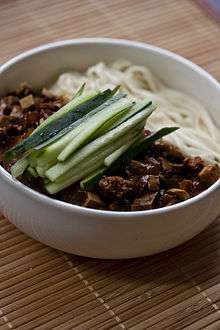 | 炸醬麵 | 炸酱面 | zhájiàngmiàn | |
Pastries
| English | Image | Traditional Chinese | Simplified Chinese | Pinyin | Notes |
|---|---|---|---|---|---|
| Fried butter cake | 奶油炸糕 | 奶油炸糕 | nǎiyóu zhágāo | ||
| Fried cake with fillings | 燙麵炸糕 | 烫面炸糕 | tàngmiàn zhágāo | ||
| Fried sesame egg cake | 開口笑 | 开口笑 | kāikǒuxiào | The dish's name literally means "open mouth and laugh/smile". | |
| Fried tofu with egg wrapping | 鍋塌豆腐 | 锅塌豆腐 | guōtà dòufǔ | ||
| Jiaoquan | 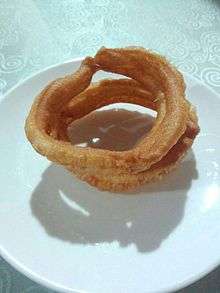 | 焦圈 | 焦圈 | Jiāoquān | Shaped like fired doughnut, but has a crispier texture |
| Steamed egg cake | 碗糕 | 碗糕 | wǎngāo | ||
| Sachima | 沙琪瑪 | 沙琪玛 | sàqímǎ | Chinese pastry of Manchu origin similar looking to Rice Krispies Treats but different in taste | |
Vegetarian
.jpg)
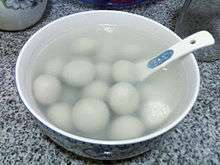

| English | Traditional Chinese | Simplified Chinese | Pinyin | Notes |
|---|---|---|---|---|
| Baked sesame seed cake | 燒餅 | 烧饼 | shāobǐng | |
| Baked wheaten cake | 火燒 | 火烧 | huǒshāo | |
| Bean jelly | 涼粉 | 凉粉 | liángfěn | |
| Bean paste cake | 涼糕 | 凉糕 | liánggāo | |
| Beijing yoghurt | 奶酪 | 奶酪 | nǎilào | |
| Buckwheat cake | 扒糕 | 扒糕 | pāgāo | |
| Cake with bean paste filling | 豆餡燒餅 | 豆馅烧饼 | dòuxiàn shāobǐng | |
| Candied fruit | 蜜餞 | 蜜饯 | mìjiàn | |
| Chatang / Miancha / Youcha | 茶湯 / 麵茶 / 油茶 | 茶汤 / 面茶 / 油茶 | chátāng / miànchá / yóuchá | |
| Chestnut broth | 栗子羹ccc | 栗子羹 | lìzǐ gēng | |
| Chestnut cake with bean paste | 栗子糕 | 栗子糕 | lìzǐ gāo | |
| Chinese cabbage in mustard | 芥末墩 | 芥末墩 | jièmò dūn | |
| Crisp fritter | 麻頁 | 麻页 | máyè | |
| Crisp fritter with sesame | 薄脆 | 薄脆 | báocuì | |
| Crisp noodle | 饊子 | 馓子 | sǎnzǐ | |
| Crisp thin fritter twist | 排叉 | 排叉 | páichā | |
| Deep-fried dough cake | 油餅 | 油饼 | yóubǐng | |
| Dried fermented mung bean juice | 麻豆腐 | 麻豆腐 | má dòufǔ | |
| Dried soy milk cream in tight rolls | 腐竹 | 腐竹 | fǔzhú | |
| Fermented mung bean juice | 豆汁 | 豆汁 | dòuzhī | |
| Freshwater snail-shaped cake | 螺螄轉 | 螺蛳转 | luósī zhuǎn | |
| Fried cake | 炸糕 | 炸糕 | zhágāo | |
| Fried cake glazed in malt sugar | 蜜三刀 | 蜜三刀 | mìsāndāo | |
| Fried dough twist | 麻花 | 麻花 | máhuā | |
| Fried ring | 焦圈 | 焦圈 | jiāoquān | |
| Fried sugar cake | 糖耳朵 | 糖耳朵 | táng ěrduō | |
| Fuling pancake sandwich | 茯苓夾餅 | 茯苓夹饼 | fúlíng jiábǐng | |
| Glazed / candied Chinese yam | 拔絲山藥 | 拔丝山药 | básī shānyào | |
| Glazed steamed glutinous rice cake | 水晶糕 | 水晶糕 | shuǐjīng gāo | |
| Glazed thin pancake with Chinese yam and jujube stuffing | 糖卷果 | 糖卷果 | táng juǎnguǒ | |
| Glutinous rice ball | 艾窩窩 | 艾窝窝 | àiwōwō | |
| Glutinous rice cake | 切糕 | 切糕 | qiēgāo | |
| Glutinous rice cake roll | 卷糕 | 卷糕 | juǎngāo | |
| Hawthorn cake | 京糕 | 京糕 | jīnggāo | |
| Honeycomb cake | 蜂糕 | 蜂糕 | fēnggāo | |
| Iced fruit | 冰果 | 冰果 | bīngguǒ | |
| Jellied beancurd | 豆腐腦 | 豆腐脑 | dòufǔ nǎo | |
| Kidney bean roll | 芸豆卷 | 芸豆卷 | yúndòujuǎn | |
| Lama cake | 喇嘛糕 | 喇嘛糕 | lǎmā gāo | |
| Millet zongzi | 粽子 | 粽子 | zòngzǐ | |
| Mung bean cake | 綠豆糕 | 绿豆糕 | lǜdòu gāo | |
| Noodle roll | 銀絲卷 | 银丝卷 | yínsījuǎn | |
| Pancake | 烙餅 | 烙饼 | làobǐng | |
| Pease pudding | 豌豆黃 | 豌豆黄 | wāndòu huáng | |
| Preserved fruit | 果脯 | 果脯 | guǒpú | |
| Purple vine cake | 藤蘿餅 | 藤萝饼 | téngluó bǐng | |
| Rice and jujube cake | 甑糕 | 甑糕 | zènggāo | |
| Rice and white kidney bean cake with jujube | 盆糕 | 盆糕 | péngāo | |
| Rice cake with bean paste | 花糕 | 花糕 | huāgāo | |
| Shortening cake | 牛舌餅 | 牛舌饼 | níushé bǐng | |
| Soybean flour cake | 豆麵糕 | 豆面糕 | dòumiàn gāo | |
| Stir fried hawthorn | 炒紅果 | 炒红果 | chǎohóngguǒ | |
| Stir-fried starch knots | 燒疙瘩 | 炒疙瘩 | chǎo gēdā | |
| Suncake | 太陽糕 | 太阳糕 | tàiyáng gāo | Not to be confused with Taiwanese suncake, whose name in Chinese is (太阳饼; 太陽餅; tàiyáng bǐng) translates more literally as "sun cookie". |
| Sweet flour cake | 墩餑餑 | 墩饽饽 | dūnbōbō | |
| Sweet hard flour cake | 硬麵餑餑 | 硬面饽饽 | yìngmiàn bōbō | |
| Sweet potato starch jelly | 粉皮 | 粉皮 | fěnpí | |
| Sweetened baked wheaten cake | 糖火燒 | 糖火烧 | táng huǒshāo | |
| Tanghulu | 糖葫蘆 | 糖葫芦 | táng húlú | |
| Tangyuan | 湯圓 | 汤圆 | tāngyuán | |
| Thin millet flour pancake | 煎餅 | 煎饼 | jiānbǐng | |
| Thin pancake | 薄餅 | 薄饼 | báobǐng | |
| Thin pancake of lard | 油皮 | 油皮 | yóupí | |
| Thousand-layered cake | 千層糕 | 千层糕 | qiāncéng gāo | |
| Veggie roll | 春餅卷菜 | 春饼卷菜 | chūnbǐng juǎncài | Not to be confused with spring rolls. |
| Watermelon jelly | 西瓜酪 | 西瓜酪 | xīguā lào | |
| Wotou | 窝头 | 窝头 | wōtóu | |
| Xing ren cha | 杏仁茶 | 杏仁茶 | xìngrén chá | |
| Xingren doufu | 杏仁豆腐 | 杏仁豆腐 | xìngrén dòufǔ | |
| Yellow cake | 黃糕 | 黄糕 | huánggāo | |
Restaurants known for Beijing cuisine
Numerous traditional restaurants in Beijing are credited with great contributions in the formation of Beijing cuisine, but many of them have gone out of business as time went by.[1][2][3][4][6][8][9][10][11][12][13] However, some of them managed to survive until today, and some of them are:

- Bai Kui (白魁): established in 1780
- Bao Du Feng (爆肚冯): established in 1881, also known as Ji Sheng Long (金生隆)
- Bianyifang: established in 1416, the oldest surviving restaurant in Beijing
- Cha Tang Li (茶汤李), established in 1858
- Dao Xiang Chun (稻香春): established in 1916
- Dao Xian Cun (稻香村): established in 1895
- De Shun Zhai (大顺斋): established in the early 1870s
- Dong Lai Shun (东来顺): established in 1903
- Dong Xin Shun (东兴顺): also known as Bao Du Zhang (爆肚张), established in 1883
- Du Yi Chu (都一处): established in 1738
- Dou Fu Nao Bai (豆腐脑白): established in 1877, also known as Xi Yu Zhai (西域斋)
- En Yuan Ju (恩元居), established in 1929
- Fang Sheng Zhai (芳生斋), also known as Nai Lao Wei (奶酪魏), established in 1857
- Hong Bin Lou (鸿宾楼): established in 1853 in Tianjin, relocated to Beijing in 1955.
- Jin Sheng Long (金生隆): established in 1846
- Kao Rou Ji (烤肉季): established in 1828
- Kao Rou Wan (烤肉宛): established in 1686
- Liu Bi Ju (六必居) established in 1530
- Liu Quan Ju (柳泉居): established in the late 1560s, the second oldest surviving restaurant in Beijing
- Nan Lai Shun (南来顺): established in 1937
- Nian Gao Qian (年糕钱): established in early 1880s
- Quanjude (全聚德): established in 1864
- Rui Bin Lou (瑞宾楼): originally established in 1876
- Sha Guoo Ju (砂锅居), established in 1741
- Tian Fu Hao (天福号): established in 1738
- Tian Xing Ju (天兴居):, established in 1862
- Tian Yuan Jian Yuan (天源酱园): established in 1869
- Wang Zhi He (王致和): established in 1669
- Wonton Hou (馄饨侯): established in 1949
- Xi De Shun (西德顺): also known as Bao Du Wang (爆肚王), established in 1904
- Xi Lai Shun (西来顺): established in 1930
- Xian Bing Zhou (馅饼周): established in 1910s, also known as Tong Ju Guan (同聚馆)
- Xiao Chang Chen (小肠陈): established in the late 19th century
- Xin Yuan Zhai (信远斋), established in 1740
- Yang Tou Man (羊头马): established in the late 1830s
- Yi Tiao Long (壹条龙): established in 1785
See also

References
- 1 2 3 4 5 6 7 8 Wang, Juling, Famous Dishes of Famous Restaurant in Beijing, Golden Shield Publishing House in Beijing, December, 2000, ISBN 7-5082-1400-5
- 1 2 3 4 5 6 Xu, Chengbei, Ancient Beijing, Customs of the General Populace of Ancient Beijing, Jiangsu Fine Arts Publishing House in Nanjing, September, 1999, ISBN 7-5344-0971-3
- 1 2 3 4 5 6 Hua Mengyang and Zhang Hongjie, Lives of the residents of Ancient Beijing, Shandong Pictorial Publishing House in Jinan, June, 2000, ISBN 7-80603-452-8
- 1 2 3 4 5 6 7 8 Du, Fuxiang and Guo, Yunhui, Famous Restaurants in China, China Tourism Publishing House in Beijing, 1982
- ↑ "Beijing Halal | China Heritage Quarterly". www.chinaheritagequarterly.org. Retrieved 2018-01-23.
- 1 2 3 Bai, Zhongjian, Legends of Historical Business in Beijing, China Tourism Publishing House in Beijing, 1993, ISBN 7-5032-0887-2
- ↑ Lo, Eileen Yin-Fei (1999). "Chinese Classics", The Chinese Kitchen, calligraphy by San Yan Wong, 1st Edition, New York, New York: William Morrow and Company, 416. ISBN 0-688-15826-9.
- ↑ Ma, Jing, Beijing Culinary Guide, China Light Industry Publishing House in Beijing, January 2002, ISBN 7-5019-3559-9/TS.2143
- ↑ Hou, Shiheng, Historical Business in Beijing, 1st Edition, Chinese Environmental Science Publishing House in Beijing, 1991, ISBN 7-80010-765-5
- ↑ Hou, Shiheng, Historical Business in Beijing, Chinese Foreign Trade Publishing House in Beijing, 1998, ISBN 7-80004-535-8
- ↑ Xu, Chengbei, Ancient Beijing, Change of Qianmen, Jiangsu Fine Arts Publishing House in Nanjing, September, 2000, ISBN 7-5344-0969-1
- ↑ Yin, Qingmin, Historical Business Establishments in Beijing, Shining Daily Publishing House in Beijing, 2004, ISBN 7-80145-812-5
- ↑ Zhou, Jianduan, Old Memory of Beijing, Social Life and Customs, Southern Cantonese Publishing House in Hong Kong, 1987, ISBN 962-04-0580-3
External links
| Wikimedia Commons has media related to Cuisine of Beijing. |
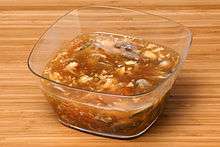
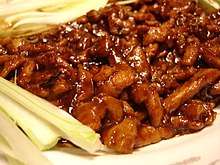
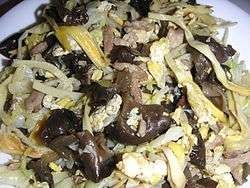


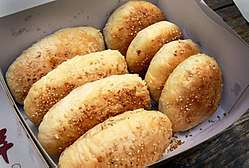
.jpg)
